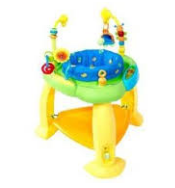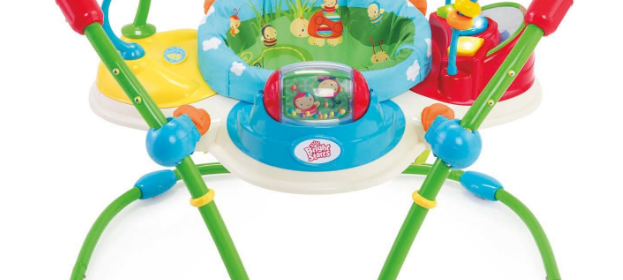Related Post
As your baby is growing, it’s important to have the right toys to help with their development through the coming months. With the help of activity jumpers, babies can establish a strong foundation for bone and muscle growth as well as boosting their fine motor skills. This list has the top-rated activity jumpers for babies that will keep them engaged and entertained.
Types
Fisher-Price Jumperoo
 Fisher-Price is one of the best companies to rely on when it comes to buying toys for your little one. Their Jumperoo collection gives babies the comfort and security they need to sit and play. The overhead canopy with hanging toys is phenomenal for encouraging the development of spatial sense and motor skills meanwhile making playtime more fun than ever before. It is incredibly stimulating with activities located all around the jumper. Once playtime is over, parents can easily pack up the unit and store it away.
Fisher-Price is one of the best companies to rely on when it comes to buying toys for your little one. Their Jumperoo collection gives babies the comfort and security they need to sit and play. The overhead canopy with hanging toys is phenomenal for encouraging the development of spatial sense and motor skills meanwhile making playtime more fun than ever before. It is incredibly stimulating with activities located all around the jumper. Once playtime is over, parents can easily pack up the unit and store it away.
Evenflo ExerSaucer
With the combination of learning, playing, and jumping, your baby will have the time of their life when they’re using the Evenflo ExerSaucer. With a 360-degree rotating bodice, babies can play with all of the interactive activities all around the jumper. They will be able to build their core strength and develop key muscles needed to promote healthy walking. With an integrated height adjustment feature, you can continue to use the unit for all ages, and it offers 2x more bounce than other jumpers on the market. Parents can also remove the toys from the unit to customize the playing experience.
Baby Einstein Musical Motion Activity Jumper
Third on the list of top-rated activity jumpers for babies is this Baby Einstein model. It offers an incredible amount of features that are not only useful for parents, but children as well. There are over 12 activities that your baby can enjoy including a light up piano that offers three different playing modes. The comfort features include a high back seat and top of the line padding for the utmost amount of comfort. The 360-degree rotating seat is essential for reaching all of the toys around the entirety of the unit so babies can have unrestricted access. With the machine washable seat, you can easily take the unit apart and sanitize it for safe play. Also, there are five different height settings, which make the unit useful throughout the most crucial years of your baby’s development.
Sassy Inspire The Senses Bounce Center
 The Sassy Inspire The Senses Bounce Center doesn’t offer as many features as the above three jumpers, but it is a cost effective and convenient solution for parents. This model offers three different height adjustment settings that can create a customized fit for your baby. The removable seat pad is great for regular cleaning and it also rotates 360 degrees, so your baby will have a full range of motion. With a mirrored spinner, play station, and wonder wheel, there are an ample amount of activities to keep your baby entertained. Also, parents can change the toys on the jumper to create new and exciting play experiences every day.
The Sassy Inspire The Senses Bounce Center doesn’t offer as many features as the above three jumpers, but it is a cost effective and convenient solution for parents. This model offers three different height adjustment settings that can create a customized fit for your baby. The removable seat pad is great for regular cleaning and it also rotates 360 degrees, so your baby will have a full range of motion. With a mirrored spinner, play station, and wonder wheel, there are an ample amount of activities to keep your baby entertained. Also, parents can change the toys on the jumper to create new and exciting play experiences every day.
If you plan on organizing company meetings in varying venues apart from your office, selecting a suitable conference venue is imminent. Regardless of the size of the meeting, if your loyal and essential customers are expected, it is always a great idea to put your best foot forward and get the best services and accommodation for your clients.
There are numerous things to bear in mind when planning a crucial business meeting. You are sure to minimize your workload if you rent a suitable venue for the kind of meeting you plan on holding. Below are a few more reasons to consider hiring a conference space for your next meeting.
Adaptability
There is no single option that works for all types of events. Depending on the nature of the event, the venue or location you plan to hire should be flexible according to your needs. Meeting venues for hire can be very adaptable, and prior announcements can be made to accommodate the needs of all types of displays.
Whether it’s a large corporate team meeting or an intimate gathering, there is a particular conference venue suitable for your desired audience. For instance, the majority of high-end hotels have various meeting rooms to accommodate all kinds of meetings.
Creates a Good First Impression
If you want to give your clients an enjoyable experience that’s worth remembering, hold your conference in a suitable location. Meeting spaces are designed to wow and include that desired first impression which is essential if you need customers to be more engaging in business with your brand.
The tools available in the conversation rooms will assist in a successful conclusion to your conference. This action will make your potential customers more trusting about your capacity to sustain them. Additionally, your main intention is to make your guests satisfied, and the conference spaces for rent are formulated to support the demands of even the stringiest visitor.
Additional Help
Let us admit it; organizing an event is no piece of cake. The whole process cannot be handled by a single individual or a few staff members. Seldom, you need specialists such as event supervisors or rally planners to prepare a successful experience.
When hiring a conference venue, some contractors are likely to offer the services of a meeting planner to help you conduct a fruitful gig. The planner will make sure clients are attended to, and the venue has all the logistics required. They will also make sure that the experience echoes your firm in the best way.
The best bit about conference venues for rent is that workers are very often ready to go that extra mile and feature services that they ordinarily don’t handle.
If you’re new to CBD, you might wonder about the fuss. CBD has provided many health benefits, from reducing anxiety and inflammation to helping with sleep and pain relief. We will discuss the top 5 things that you can do with CBD. Keep reading to learn more.
Mix Them
While mixing alcoholic beverages is common in the bartender world, it is not often done with CBD oil. However, there are a few bartenders who have started to experiment with CBD cocktails. The results have been mixed (pun intended). Some people say that CBD makes them feel more relaxed and less anxious, while others find it doesn’t do much for them. If you’re interested in trying a delta 9 THC free CBD cocktail, ask your bartender if they can make you one.
CBD Oil and Coffee
If you love coffee but find it sometimes makes you feel jittery or anxious, adding a little CBD oil to your cup may help calm those nerves. You can buy CBD oil online or at some health food stores. Start by adding a drop or two of oil to your coffee and see how you feel. If you don’t notice any difference, you can try increasing the amount you use until you find the right dose for you.
Make CBD Gummies
 If you’re looking for an easy and delicious way to take CBD, making your own gummies is a great option. You can find CBD gummy molds online or at your local craft store. Simply add the oil to your favorite gummy recipe and let the mixture set in the mold. Once they’re firm, you can enjoy your homemade CBD gummies any time of day.
If you’re looking for an easy and delicious way to take CBD, making your own gummies is a great option. You can find CBD gummy molds online or at your local craft store. Simply add the oil to your favorite gummy recipe and let the mixture set in the mold. Once they’re firm, you can enjoy your homemade CBD gummies any time of day.
Add It to Your Beauty Routine
CBD oil is not just for ingestion. You can also use it in your beauty routine to help improve the appearance of your skin. CBD oil is known for its anti-inflammatory properties, which can help reduce redness and swelling. It can also help hydrate the skin and protect it from environmental damage. Simply add a few drops of oil to your favorite lotion or cream and apply it to your skin like any other product.
Take It Sublingually
If you want to experience the fastest possible relief from CBD, taking it sublingually (under the tongue) is the way to go. Taking CBD oil sublingually bypasses the digestive system and is absorbed directly into the bloodstream. This means that it takes effect more quickly than if you were to ingest it. Simply place a few drops of oil under your tongue and hold it there for 30-60 seconds before swallowing.
CBD has become increasingly popular in recent years, as more people are beginning to learn about its many potential health benefits. If you’re thinking about trying CBD, you should keep a few things in mind:
- Make sure to purchase your oil from a reputable source.
- Start with a small dose and increase gradually as needed.
- Experiment to find the method of consumption that works best for you.
Do you have any questions about CBD? Let us know in the comments below.




